A Volcanic Highway for the Lost Tribes?
by John P. Pratt
Reprinted from Meridian Magazine (15 Sep 2005).
©2005 by John P. Pratt. All rights Reserved.
Index,
Home
Israelites will return from the north on a highway cast up in the midst of the great deep.
The tenth Article of Faith of the LDS Church begins, "We believe in the literal gathering of Israel
and in the restoration of the Ten Tribes . . . " One aspect of the restoration of those tribes is that a highway will be "cast up in the midst of the great deep" for their return (D&C 133:27). Let us consider just what that might mean.
Ten[1] of the twelve tribes of Israel were taken into captivity into Assyria over seven centuries before Christ. They did not return, and have become known as the "Lost Ten Tribes" of Israel. The Lord has made it clear that he has not forgotten them and that some of their descendants will receive all of the blessings of the restored gospel.
There is uncertainty about the extent to which the lost tribes might have stayed together. What is certain is that some of the tribes were scattered to the four winds over much of the earth (Amos 9:9, 1 Nep. 22:3-5), and that some of the tribes will return from the north (D&C 110:11).
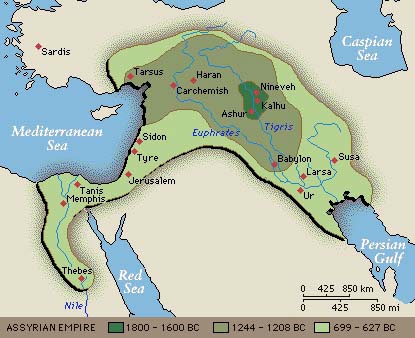 |
The Lost Tribes never returned from Assyria.
This article does not speculate about the location of the lost tribes, nor the degree to which they remained as one body. To be unambiguous, in this paper "lost tribes" refers to the entire group that disappeared, "scattered tribes" refers to those who became dispersed, and "northern tribes" refers to those who will return from the north. There may be a lot of overlap among the tribes counted in each of those definitions.[2] Having thus attempted to define terms, let us now turn to what the scriptures tell us about the return of the northern tribes.
1. Prophesied Return
There are many scriptures which prophesy the return of the northern tribes. In the Old Testament,
Isaiah and Jeremiah are probably the principal exponents (Isa. 11:10-16; Jer. 3:18; 16:14-21). When the Angel Moroni first appeared to the Prophet Joseph Smith, he quoted this verse from Isaiah and announced that it was soon to be fulfilled (JS-H 1:40):
And there shall be an highway for the remnant of his people, which shall be left, from Assyria; like as it was to Israel in the day that he came up out of the land of Egypt. (Isa. 11:16)
So there will be a "highway" for the tribes to return from their Assyrian captivity that will in some way be like the highway that the Lord produced for the children of Israel to escape from Egypt. What was that highway? One feature was that it divided the sea, so they could pass over. Is that the way in which the new highway will be similar to it?
Another prophecy of Isaiah was later explained by modern revelation:
And the parched ground shall become a pool, and the thirsty land springs of water:
in the habitation of dragons, where each lay, shall be grass with reeds and rushes.
And an highway shall be there, and a way, and it shall be called The way of
holiness; the unclean shall not pass over it; but it shall be for those: the wayfaring
men, though fools, shall not err therein.
No lion shall be there, nor any ravenous beast shall go up thereon, it shall not be
found there; but the redeemed shall walk there:
And the ransomed of the Lord shall return, and come to Zion with songs and
everlasting joy upon their heads: they shall obtain joy and gladness, and sorrow and
sighing shall flee away. (Isa. 35:7-10)
One key to understanding this somewhat enigmatic allusion to the northern tribes, and especially to the highway, was revealed in modern times. The Lord explains:
And they who are in the north countries shall come in remembrance before the
Lord; and their prophets shall hear his voice, and shall no longer stay themselves;
and they shall smite the rocks, and the ice shall flow down at their presence.
And an highway shall be cast up in the midst of the great deep.
Their enemies shall become a prey unto them,
And in the barren deserts there shall come forth pools of living water; and the
parched ground shall no longer be a thirsty land.
And they shall bring forth their rich treasures unto the children of Ephraim, my
servants.
And the boundaries of the everlasting hills shall tremble at their presence.
And there shall they fall down and be crowned with glory, even in Zion, by the
hands of the servants of the Lord, even the children of Ephraim.
And they shall be filled with songs of everlasting joy. (D&C 133:26-33)
Note how clearly the Lord explains the verses from Isaiah 35 quoted above,
which also mention the "parched ground," "songs of everlasting joy," and the focus of this article,
the "highway" (compare Isa. 11:16, 62:10). It is this passage that contains the cornerstone verse which this article seeks to understand, that a "highway shall be cast up in the midst of the great deep."
1.1 Highway of Holiness
Because D&C 133 so clearly refers to and explains Isaiah 35, we can also infer that
the other details which Isaiah adds also refer to the highway. In particular, Isaiah states that "it shall be
called The Way of Holiness; the unclean shall not pass over it" and "the redeemed shall walk there." That would be an unusual highway indeed, if only the righteous could walk on it.
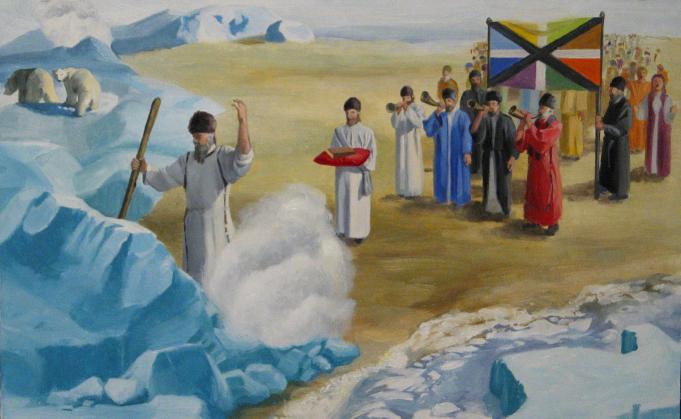 |
"The Northern Tribes Return" by Mary Pratt Parker
1.2 One Literal Interpretation
Early in the Church, D&C 133 was usually interpreted literally, that is, "highway" means a major road, "ice" means ice, "walk" means walk, and "great deep" means ocean, suggesting a picturesque scene something like the above painting.[3] For example, the apostle Orson Pratt, commenting on those verses, explained:
"To show that they come with power they come on a highway cast up for them; and ice feels the power of God and flows down, making room for them; and the barren deserts of the
north, wherever they may go and need water, will yield forth pools of living water to
quench their thirst. As they come to sing in the height of Zion, the everlasting hills, this
great Rocky Mountain range, extending from the arctic regions south to the central portions
of America, will tremble beneath the power of God at the approach of that people. . . . But where have this great company been, where has this mighty host come from? They have come from their hiding
place in the north country; they have been led thence by the Prophets of the Most High
God, the Lord going before their camp, talking with them out of the cloud, as he talked in
ancient days with the camp of Israel, uttering his voice before his army, for his camp will
be very great." [4]
 |
Could the highway be a trans-oceanic mass transit system?
1.3 Figurative Interpretation
Elder Pratt's interpretation was given in 1875, while there were still many unexplored areas in the
north countries. As time went on, Robert Peary's expedition claimed victory over the North pole
in 1909. The accuracy and coverage of our maps improved, and there appeared to be fewer and
fewer places where the northern tribes could be residing. As that happened, some LDS writers shifted
to a more figurative interpretation. For example, B.H. Roberts concluded that D&C 133 was not the Lord speaking about actual events to be interpreted literally, but rather figurative events were described with hyperbole. He did not suggest just what figurative interpretation might be correct, but only warns us not to fall into the trap of believing that such fantastic events might actually occur.[5] So which is correct? Are those verses literal or figurative? Or both?
2. What Does Science Say?
What does science say about a literal interpretation? Could there be multitudes of people living
in areas so far north that ice could flow down at their presence? Are there areas in the north that are
still uncharted? Are there known scientific processes that could quickly cast a highway up in a deep ocean? Could enough heat be generated to cause large blocks of ice to melt quickly? And what about that requirement that only the righteous can walk on the Highway of Holiness?
First, the idea of multitudes of people existing at some unknown location on the earth is now so remote that scientists would allow virtually zero chance of that happening. We can all browse satellite
images on the internet of north countries without finding any uncharted areas.
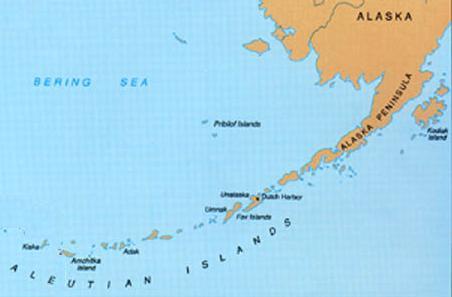 |
The Aleutian Islands are a volcanic chain, but not a "highway."
As for the question about the rapid formation of a land bridge, that would also require a process unknown to modern science. Of course, volcanoes can form rapidly and produce enough heat to melt ice, but they tend to form mountains rather than land bridges. They do often occur along a fault line, such as the string of volcanic Aleutian Islands off the coast of Alaska, or the volcanoes in Oregon and Washington.[6] But the best examples science has to offer are strings of isolated volcanoes which are more like stepping stones than a land bridge. The "highway" described in D&C 133 sounds like a mountain range that arises from the depths of the ocean so that the peaks protrude from the water and ice to form a land bridge. That matches a feature like the isthmus of Panama, but such a land bridge is believed to require a long time to form. Thus, science knows of no way to produce a highway in the depths of the sea quickly by natural means. A more modern form of transportation such as airways or a transit system does not seem to fit the description that the redeemed will "walk" on it (Isa. 35:9), much less the requirement that only the righteous can do so.
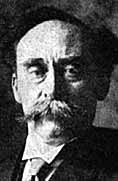 |
Robert Peary rode dog-sleds to the north pole.
Thus, modern science would say there is virtually no chance of a literal fulfillment of the
prophecies of a highway being cast up in the deep ocean on which the northern tribes could return from an unknown location in the arctic. If it were to happen, many scientists would call it a miracle indeed.
3. What if?
Now let us consider a very unlikely hypothesis, at least from the scientific perspective. What if the literal interpretation is correct? What if a scene very much like Mary Pratt Parker's illustration above actually were to take place? To me it
would explain a lot of other unusual scriptures, so it is worth considering as a possibility. Such an event may be out of the reach of modern science, but surely not beyond the powers of God.
3.1 A Major Miracle
First of all, if a land bridge suddenly appeared out of the depths of the ocean, connecting the North
American continent to some island or other continent in the north, and the ice flowed down, and
the northern tribes were to return across it, bringing their treasures, and if their
enemies could not impede them, nor even walk on the highway, then it would be a miracle indeed!
In fact, think about it for a moment. If that were really to happen tomorrow, it would be on all
world news coverage for months. But it would be much more than just a major earthquake or
volcano. This would be an event of worldwide impact which would clearly "make bare the arm of
the Lord," that is, it would clearly show the hand of God.
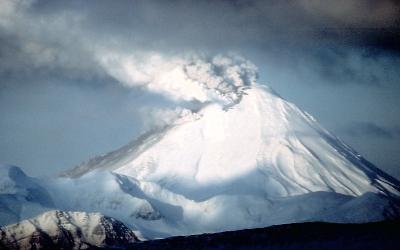 |
Volcanoes melt ice easily.
The Second Coming will be preceded by many great signs and wonders, but this one would be
different from most of them. When the crops of the earth are destroyed by a hail storm or the sea heaves beyond its bounds, it will appear only to be an unfortunate natural disaster. When the sun is darkened and the moon turns to blood, scientists will also
no doubt have a natural explanation. When the great sign of the coming of the Son of Man
is given, the Prophet Joseph Smith explained that scientists would call it a new planet or a star.[7] If a land bridge suddenly came up in the ocean, then even that could be called a natural event, although very unlikely.
What would make the hand of God manifest would be multitudes of people appearing from places unknown, with only the holy able to walk on the highway. Combining that with so many of the
prophecies in Isaiah of the return of the northern tribes being fulfilled, as well as those in the Book of Mormon and Doctrine and Covenants, means people worldwide would have to be spiritually blind not to see the hand of God.
3.2 Greater Than Parting the Red Sea
In fact, this would be one of the greatest miracles ever performed by the Lord. When
Jesus healed the sick, it was a sign of his identity, but many remained unconvinced. One comparable event is when Moses parted the Red Sea for the children of Israel to complete
their exodus from Egypt. But even that looked like a natural event to pharaoh, as had all of the
other miracles of Moses, and he led his troops into the highway across the sea. Because he could
not see the hand of God, he paid a great price, and he and his armies were destroyed.
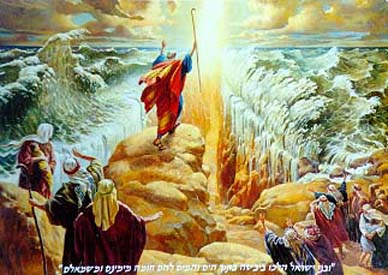 |
What could be greater than parting the Red Sea?
But if the northern tribes were to return on a highway cast up in a deep ocean, it would far overshadow
even this great miracle of Moses in magnitude. In fact, it would appear in retrospect that Israel
passing over the Red Sea on a highway through the deep was merely a type foreshadowing the great
passing over which would occur on a much grander scale in the last days.
Moreover, it would perfectly explain a somewhat mysterious scripture. Jeremiah prophesied that,
Therefore, behold, the days come, saith the Lord, that it shall no more be said,
The Lord liveth, that brought up the children of Israel out of the land of Egypt;
But, The Lord liveth, that brought up the children of Israel from the land of the
north, and from all the lands whither he had driven them: and I will bring them
again into their land that I gave unto their fathers. (Jeremiah 16:14-15.)
Think about that. Every year the Jews celebrate Passover, remembering the exodus (on the first day of Passover) and the parting of the Red Sea to pass over to freedom (on the last day of Passover). What would it take to get them to
cease referring to those events and replace them with another? When Joshua parted the waters of the
Jordan River for Israel to pass over into the promised land, did that become the new miracle which
defined their Lord? No, because it was not nearly so impressive. Would it not take an even more miraculous event to eclipse the great miracles of Moses? The rising of a highway from the depths of an ocean would definitely qualify to explain the prophecy of Jeremiah because it would both be truly a wonder, and would also reveal the arm of the Lord.
3.3 A Marvelous Wonder
The prophet Nephi in the Book of Mormon describes a great and marvelous work that will occur in
the last days. It relates to the appearance of new scriptures which will testify of
the truthfulness of the Bible and of Jesus Christ as the Savior of mankind. The beginning of this
work refers to the coming forth of the Book of Mormon, the ancient Nephite record
which is another testament of Jesus Christ (1 Nephi 22:8-9, 2 Nephi 25:17-18).
But as has been pointed out, the appearance of the Book of Mormon is just the beginning of this
work.[8] After Nephi describes his vision of the coming forth of the Book of Mormon (1 Nephi 13:34-37), it is only in the following chapter that he describes the Lord's marvelous work and wonder:
For the time cometh, saith the Lamb of God, that I will work a great and a
marvelous work among the children of men; a work which shall be everlasting,
either on the one hand or on the other—either to the convincing of them unto peace
and life eternal, or unto the deliverance of them to the hardness of their hearts and
the blindness of their minds unto their being brought down into captivity, and also
into destruction, both temporally and spiritually, according to the captivity of the
devil, of which I have spoken. (1 Nephi 14:7)
Also referring to this great and marvelous work, Nephi added:
And after our seed is scattered the Lord God will proceed to do a marvelous work
among the Gentiles, . . .
Wherefore, the Lord God will proceed to make bare his arm in the eyes of all the
nations, in bringing about his covenants and his gospel unto those who are of the
house of Israel.
Wherefore, he will bring them again out of captivity, and they shall be gathered
together to the lands of their inheritance; and they shall be brought out of obscurity
and out of darkness; and they shall know that the Lord is their Savior and their
Redeemer, the Mighty One of Israel. (1 Nephi 22:8, 11-12).
Before these verses, Nephi talked about the Book of Mormon being restored, and how readers
would be blessed if they accept the new scripture, and cursed otherwise. But these verses seem to be
saying that after a sufficient time had gone by, the Lord will work a truly astounding miracle
which will make it clear that the restoration is indeed his work. It will be tied to the coming forth of new scripture and to the bringing of Israel "out of obscurity." A land bridge coming up out of the ocean
would fulfill this prediction perfectly because a) everyone should call it miraculous, b) the hand
of God would be revealed, c) it brings Israel out of its obscure hiding place, and d) if the treasures brought include scriptures (2 Nephi 29:12-13), then it also would help bring forth yet another witness for Jesus Christ. In other words, an important part of the Lord's marvelous work might be raising this land bridge, which would either convince people to accept the gospel or to harden their hearts against it.[9]
3.4 The First Coming
Concerning Nephi's prophecy of a marvelous wonder which will cause a great division among the
people, causing them to see the hand of God and either accept or reject the message, note that there was a similar occurrence in the Book of Mormon.
The coming of Christ to the Nephites was clearly a small-scale similitude of his Second Coming to
the entire world. It was preceded by entire cities being destroyed by fire, or wind, or being buried
in the ocean or by mountains. In fact, there was a complete destruction of the wicked of that area.
The survivors still had much need of repentance, but when the Savior arrived, they were all converted.
Some thirty-three years earlier, there had been a great and
marvelous work performed wherein all could see the hand of God revealed. Up until that time, believers had clung to prophecies that Christ would come, but they had little hard evidence and much faith was required. A day was set apart for the believers to be executed. Then the astounding miracle occurred, exactly as prophesied. After the sun went down, it stayed as light as mid-day all during the night (3 Nephi 1:19). Because it precisely fulfilled prophecy and was such an unlikely event to have occurred naturally, it caused a huge division in the people. Many more now believed, but many others hardened their hearts even more. After the hard-hearted had several years to repent, they were finally destroyed so that an era of peace could begin.
If the Highway of Holiness were to arise in the great deep, would it not have a similar effect?
3.5 Hidden, Not Lost
An important concept here is that the Ten Tribes are not just lost, they were actually hidden by the
hand of the Lord (Jacob 5:14). Several LDS authorities have explained that the lost tribes had indeed
been hidden. For example:
"Restoration of the Lost Tribes. From the scriptural passages already
considered, it is plain that, while many of those belonging to the Ten Tribes were
diffused among the nations, a sufficient number to justify the retention of the
original name were led away as a body and are now in existence in some place
where the Lord has hidden them." — James Talmage[10]
"Ministers Among Lost Tribes. When the Savior taught the Nephites, he
informed them that he had "other sheep" which were not of the Nephites, neither of
the land of Jerusalem, and these also were to hear his voice and be ministered to by
him. It is reasonable for us to conclude that among these others, who were hidden
from the rest of the world, he likewise chose disciples — perhaps twelve — to
perform like functions and minister unto their people with the same fulness of
divine authority." — Joseph Fielding Smith[11]
Note the huge difference between these two concepts of lost and hidden. If someone is just lost, then rescue crews
can search the area, and be somewhat confident that a thorough search should find him. But if a
person is hiding, then locating him can be much more difficult. The modern satellite system with
high resolution anywhere on earth has not yet located Osama bin Laden. If the
Lord is hiding someone, then who would be so bold as to say that a certain location is ruled out as the hiding place because it has been searched. When the Lord wanted to hide the entire western hemisphere from the rest of the world, no one could sail across the ocean to find it (2 Nephi 1:8). When the Lord wanted to hide himself, he could walk unnoticed through a crowd of people to whom he was just preaching, who wanted to kill him (Luke 4:30, John 8:59). If he can do that as part of his
daily routine, surely he can hide whatever he wants from whomever he pleases. Let us remember
that we are talking about God, who created the heavens and the earth and all things which in them
are, as well as our eyes and minds.
4. Conclusion
The scriptures clearly teach that Israelites will someday return from the north countries. The Lord has revealed that they will do so on a highway that is cast up in the great deep. If that is interpreted literally, science has no explanation of where they might be located, much less for the sudden appearance of a land bridge across a deep ocean. Therefore, if the prophecy in D&C 133 of their return as a group along a highway is fulfilled literally, it would be a miracle. Such an event could cause
many more to believe in the restoration, and others to vow to fight against it more vehemently.
Time will tell just how literally the Lord meant this prophecy of a highway to be interpreted, but in
any case it should be a marvelous event to witness.
The author thanks William L. Walker, Jr., James F. Pratt, Avraham Gileadi, Ronald P. Millett,
and Thomas W. Mackay for enlightening discussions and most of the good ideas presented. And our beloved prophet, President Gordon B. Hinckley, must be thanked for challenging us all to reread the Book of Mormon, which led directly to this article.
Notes
- The Bible describes a simple division of the twelve tribes into two and ten. The nation of
Judah was Judah and Benjamin, whereas Israel was Ephraim, Manasseh, Dan, Naphtali, Asher,
Reuben, Simeon, Gad, Issachar and Zebulon. The priestly tribe of Levi was spread throughout all
the tribes and not counted in this enumeration. Many Bible commentators have chosen to add
Simeon to Judah's group. Moreover, it is usually understood that half the tribe of Benjamin went
with Israel and only half stayed with Judah. Thus, scholars tend to count the lost tribes as either
being ten and a half tribes (James Talmage, The Articles of Faith, SLC: LDS Church, 1961, p.
315) or nine and a half, if they count Simeon with Judah (Bruce R. McConkie, The Millennial
Messiah, p. 221). The problem is discussed by John Tvedness in "The Other Tribes: Which Are
They?" Ensign (Jan 1982), p. 31. As for Judah, after the crucifixion of Jesus Christ, they were
also scattered to the four winds. Thus, all twelve tribes have been outcasts.
- For the following reason, it appears to me that not all ten of the lost tribes later went north. The
revelation in Zechariah 6:1-8 seems to imply that Dan, Naphtali and Asher went north, as
represented by the black horse. (Those tribes were assigned to the north in Num. 2:25-31, and
Dan's color is black, as discussed in my "Cornerstone Constellations" article.) It also states the
tribes assigned to the west (Ephraim, Manasseh and part of Benjamin), represented by the white
horse, followed after them, also going north. But the grisled (multi-colored) horse, most likely
representing several of the other tribes, went south, likely led by Reuben (leader of the south,
Num. 2:10-16), which might well include southern Europe from Romania to Spain. The bay
horses, which wandered to and fro in the earth, seem to represent Judah, who at that time had gone
to Babylon and back ("to and fro"). That interpretation is expanded in Zech. 1:8-10 that those
who wander "to and fro" are even better represented by three horses: a red, speckled and white.
From the colors derived for the tribes last month, those would be Judah (red), Benjamin (red and
white striped), and Ephraim/Manasseh (white). The latter may have been included here because
Lehi (of Manasseh, Alma 10:3) also left just before Judah went into captivity, and they grew into a
great nation, worthy of being included, but separate from the lost tribes.
- "The Northern Tribes Return," an oil painting by Mary Pratt Parker, designed by the author for this article. The leading prophet who smites the rocks and ice wears white, symbolic of Ephraim, as does the second man who carries one of their treasures, their scriptures. A steamy mist rises from the melting ice. The four men sounding the trump are dressed in the colors of the four winds (and four principal tribes of Israel), whereas both men carrying the banner wear black, symbolizing Dan. Dan is the leader of the tribes of the north (Num. 2:25), so black is the color of the prominent St. Andrew's cross on the flag, and also the principal color of the hats. The white cross on the flag symbolizes Ephraim and Manasseh, and the other colors represent the other tribes as discussed in last month's article. (See Pratt, John P., "Twelve Sons, Twelve Stones," Meridian Magazine, 3 Aug 2005.) Those colors are yellow-green (Zebulon), tan (Issachar), orange (Gad), green (Simeon), purple (Levi), royal blue (Reuben), light blue (Naphtali) and yellow (Asher). The multitudes who follow are singing songs of everlasting joy.
- Orson Pratt, Journal of Discourses, Vol.18, p. 24 (April 11, 1875).
- B. H. Roberts, Defense of the Faith and the Saints, (Salt Lake City: Deseret News, 1912) Vol. 2, p. 481, states:
" . . . we of course must be prepared to take
into account the figurative language they speak. It is possible that if we fail to do
this, we shall misapprehend, in part, some material fact of their message. Especially
should one be on his guard in such highly picturesque matters as the return of the
lost tribes from their long dispersion—from the lands of the north. In such an event
not only will 'mountains of ice flow down' at the presence of their prophets, but
highways will be cast up in the midst of the great deep—their enemies will become a
prey unto them—in barren deserts shall come forth pools of living water—the
parched ground shall no longer be a thirsty land—the 'boundaries of the everlasting
hills shall tremble at their presence!' (Doc. and Cov., sec. 133.)
We must make some allowance, I repeat, for the hyperbole of that language in
which the message of these prophets is delivered . . ."
- Pratt, John P., "Devouring Fire: Volcanoes and Scripture," Meridian Magazine (17 Dec 1999).
- Smith, Joseph, Jr., Teachings of the Prophet Joseph Smith, (Salt Lake City: Deseret Book, 1976), p. 287.
- Gileadi, Avraham, The Last Days (Orem, Utah: Book of Mormon Research Foundation, 1998), Chapter 2.
- It is interested that Joseph Fielding Smith used both of the words "marvelous" and "wonderful" when he described the highway. He said in The Way to Perfection, p. 125:
"When the 'lost tribes' come — and it will be a most wonderful sight and a marvelous thing when they do come to Zion — in fulfillment of the promises made through Isaiah and Jeremiah, they will have to receive the crowning blessings from their brother Ephraim, the 'first-born' in Israel."
- James E. Talmage, Articles of Faith, ch. 18, p. 340-341.
- Joseph Fielding Smith Jr., Doctrines of Salvation, vol. 3, p. 159.







